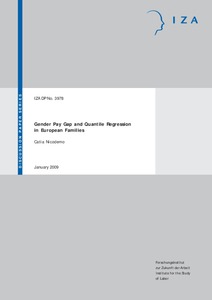Gender pay gap and quantile regression in European families

Institute of Labor Economics, Bonn
IZA - Bonn
2009
35 p.
gender ; gender discrimination ; statistics ; wage differential
Discussion Paper Series
3978
Wages and wage payment systems
English
Bibliogr.
"In this paper we analyze the trend of the gender gap between wives and husbands for Mediterranean countries with a strong family tradition, using data from the European Household Panel (ECHP) of 2001 and the European Survey on Income and Living Conditions (EU-SILC) of 2006. In general, wives and husbands, when married, have the same characteristics but wives suffer from two types of discrimination with respect to husbands: a lower wage for the same work and a primary responsibility for children. This paper uses quantile regression and counterfactual decomposition methods to investigate whether a glass ceiling exists or if instead a sticky floor is more prevalent among European families over time (2001 and 2006). We correct for selectivity the unconditional wage distribution of married women and we show that the wage gap decomposition is different if we ignore self-selection. We find that the wage gap is positive in each country, and the greater part of it is composed of a discrimination effect, while the characteristics effect is small. In Mediterranean countries, wives suffer from the sticky floor effect, i.e. the gender gap is bigger at the bottom of distribution, while we can observe that the glass ceiling effect decreased in most countries in 2006. "
Digital
The ETUI is co-funded by the European Union. Views and opinions expressed are however those of the author(s) only and do not necessarily reflect those of the European Union or the ETUI.